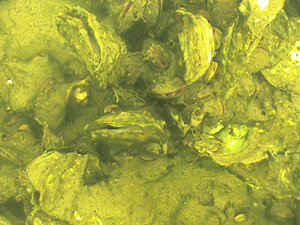|
Ramsar Convention on Wetlands: A new opportunity for international
conservation of bivalve reefs

| Staff from
The Nature Conservancy attended the Ramsar COP11 meeting to educate
representatives from signatory countries about the importance of bivalve
reefs and the helpful role of the Ramsar Convention in reversing global
losses of this important habitat. Photo: Rob
Brumbaugh/TNC. |
The Convention on Wetlands of International Importance
was created in 1971 to help curb the accelerating loss of wetlands
globally, and to increase international collaboration on wetland
conservation overall. Dubbed the"Ramsar Convention" after the Iranian city in
which it was drafted, it is the only international policy agreement that
focuses exclusively on promoting the wise use and protection of the
world's wetlands. At present, there are 163 signatory countries
working collaboratively to protect wetlands at 2,053 designated Ramsar
Sites covering nearly 194 million hectares (approximately 480 million
acres). How is this related to shellfish and bivalve habitat like oyster
reefs?
One of the key recommendations in a
recent global assessment of oyster reef condition (Beck et al. 2011) was to protect bivalve reefs under
international agreements such as the Ramsar Convention. Wetlands are
defined rather broadly under the convention, and the list of eligible
wetland types includes other structured aquatic habitats such as coral
reefs down to 6 meters depth, but until recently did not specifically
include bivalve reefs. Over the past two years, scientists from The
Nature Conservancy worked closely with the Ramsar Scientific and
Technical Review Panel (STRP) to compile the necessary information to
support bivalve reefs being included among the list of wetland types
eligible for nomination as a Ramsar Site. Fortunately, the STRP was in
the process of updating the nomination materials including the Ramsar
Information Sheet (RIS) that countries use to nominate new sites, so the
timing was perfect for making this addition to the list. In July 2012,
the Convention's signatory countries convened at the 11th
triennial Conference of Parties (COP-11) in Bucharest, Romania and
passed a resolution to adopt the RIS with its updated list of eligible
wetland types. This revised data sheet will be available for voluntary
use by countries as early as April 2013 after some final formatting
details are addressed. While this addition to the list of wetland types
may seem a relatively small change, it represents a huge new opportunity
for countries to nominate and protect new sites that have bivalve reefs
at their core. Such increased international attention and collaboration
could be a powerful way to reversing decades of loss that have all but
eliminated oyster reefs from some regions of the world.

|
Oyster Filtration Past and Present: Putting Numbers on Ecosystem Services.

| Oysters filtering water in Quicksand Pond on
the east side of Narragansett Bay, RI, in 2005. Photo: Rob
Brumbaugh/TNC.
|
Oyster reefs provide a suite of valuable ecosystem
services, from enhancing fisheries production through to providing
coastal protection. But quantifying those services is frequently
challenging, and none more so than the service of water filtration.
While there are many laboratory based measurements, few studies have
attempted to quantify this service in the field, where conditions are
variable and frequently suboptimal. Such quantification is, however, a
critical next step for both restoration and management.
A new study led by TNC and published this
month in Estuaries and Coasts provides many of the answers. The
scientists involved used field based measurements to build a model for
estimating the volume of water filtered by oyster populations in the
field. They then used this model and data on the historical and modern
oyster populations from an earlier publication to estimate the volume of water
filtered historically (c. 1900) and presently in 13 estuaries around the
East and Gulf coasts.
The study reveals that oyster filtration
declined in 12 of the 13 estuaries examined, and by a mean of 85%. This
is likely to have had a significant effect on the ecology of impacted
estuaries. For example, whereas in Matagorda Bay TX, the oyster
population historically filtered a volume equivalent to 320 Fenway Park
stadiums an hour, it now filters just 2. This estuary is just 1 of 6 in
the Gulf of Mexico in which the historic oyster population was capable
of filtering the full volume of the estuary within its residence time;
an indication that filtration by oysters was historically a dominant
force. Now, only one of the 8 estuaries examined in the Gulf of Mexico
achieves this feat.
Filtration is a valuable ecosystem service.
By increasing the water clarity, oyster filtration promotes the growth
and recovery of seagrasses, which themselves also have a high economic
value, as highlighted in another recent study.
But it isn't all bad
news. The study also highlights some bright spots for management, with
Apalachicola Bay showing an increase in filtration pressure from
historic; evidence that with sound management of oyster reefs and river
flows (ever more critical given regional water management challenges),
it is possible to maintain an oyster population capable of providing
significant ecosystem function and a productive oyster
fishery.
By providing an insight into the ecological impact of
the historic and present oyster population, this study helps identify
estuaries where large scale impacts of oyster filtration have been lost.
More critically still, it creates a framework for estimating the amount
of restoration required to bring oyster back to the level where they can
once again provide this important service at a large
scale.
Funding support for this study was provided by the
National Fish and Wildlife Foundation (NFWF), the National Partnership
between TNC and NOAA Restoration Center, The Turner Foundation and the
TNC-Shell Partnership. For more information, please contact Dr. Philine zu Ermgassen.
Upcoming Events and Conferences
Northeast Aquaculture
Conference & Exposition/Milford Aquaculture Seminar/International
Conference on Shellfish Restoration Special Joint
Meeting
Aquaculture and Restoration: A Partnership
December
12-15, 2012 Mystic Marriott Hotel & Spa Groton,
CT
Note: If you would like to contribute an article or submit items for
the "Looking Ahead" section, please contact
Boze
Hancock.
Oyster Restoration Publications and
Resources
Oyster Restoration Working Group Research and
Reports
The Practitioner's Guide to
Shellfish Restoration: An Ecosystem Services Approach,
as well as back issues of the Shellfish Restoration
Clamor are available online. Cool
Video!
"Sink Your Shucks" Shell Recycling
Program
Harte Research Institute, Texas A & M
University
Corpus Christi, Texas |






